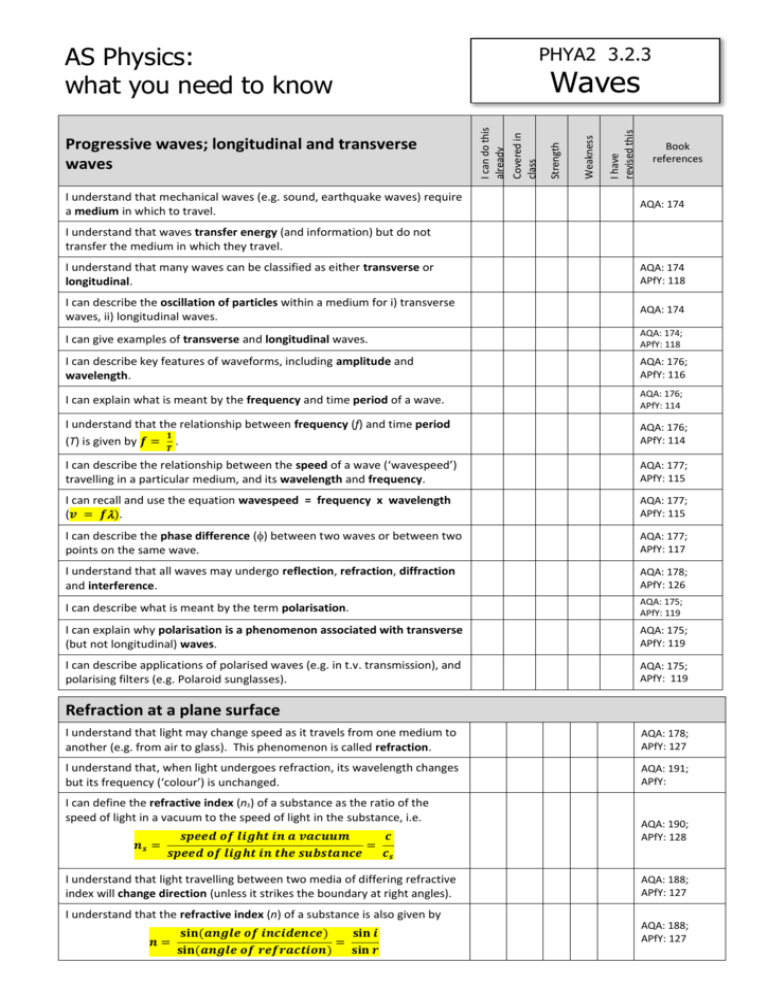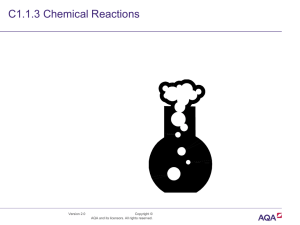Progressive waves - www.aqaphysics.co.uk
advertisement

AS Physics: what you need to know I understand that mechanical waves (e.g. sound, earthquake waves) require a medium in which to travel. I have revised this Weakness Strength Covered in class Waves I can do this already Progressive waves; longitudinal and transverse waves PHYA2 3.2.3 Book references AQA: 174 I understand that waves transfer energy (and information) but do not transfer the medium in which they travel. I understand that many waves can be classified as either transverse or longitudinal. AQA: 174 APfY: 118 I can describe the oscillation of particles within a medium for i) transverse waves, ii) longitudinal waves. AQA: 174 I can give examples of transverse and longitudinal waves. AQA: 174; APfY: 118 I can describe key features of waveforms, including amplitude and wavelength. AQA: 176; APfY: 116 I can explain what is meant by the frequency and time period of a wave. AQA: 176; APfY: 114 I understand that the relationship between frequency (f) and time period 𝟏 (T) is given by 𝒇 = . AQA: 176; APfY: 114 I can describe the relationship between the speed of a wave (‘wavespeed’) travelling in a particular medium, and its wavelength and frequency. AQA: 177; APfY: 115 I can recall and use the equation wavespeed = frequency x wavelength (𝒗 = 𝒇). AQA: 177; APfY: 115 I can describe the phase difference () between two waves or between two points on the same wave. AQA: 177; APfY: 117 I understand that all waves may undergo reflection, refraction, diffraction and interference. AQA: 178; APfY: 126 I can describe what is meant by the term polarisation. AQA: 175; APfY: 119 I can explain why polarisation is a phenomenon associated with transverse (but not longitudinal) waves. AQA: 175; APfY: 119 I can describe applications of polarised waves (e.g. in t.v. transmission), and polarising filters (e.g. Polaroid sunglasses). AQA: 175; APfY: 119 𝑻 Refraction at a plane surface I understand that light may change speed as it travels from one medium to another (e.g. from air to glass). This phenomenon is called refraction. AQA: 178; APfY: 127 I understand that, when light undergoes refraction, its wavelength changes but its frequency (‘colour’) is unchanged. AQA: 191; APfY: I can define the refractive index (ns) of a substance as the ratio of the speed of light in a vacuum to the speed of light in the substance, i.e. 𝒔𝒑𝒆𝒆𝒅 𝒐𝒇 𝒍𝒊𝒈𝒉𝒕 𝒊𝒏 𝒂 𝒗𝒂𝒄𝒖𝒖𝒎 𝒄 𝒏𝒔 = = 𝒔𝒑𝒆𝒆𝒅 𝒐𝒇 𝒍𝒊𝒈𝒉𝒕 𝒊𝒏 𝒕𝒉𝒆 𝒔𝒖𝒃𝒔𝒕𝒂𝒏𝒄𝒆 𝒄𝒔 I understand that light travelling between two media of differing refractive index will change direction (unless it strikes the boundary at right angles). I understand that the refractive index (n) of a substance is also given by 𝐬𝐢𝐧(𝒂𝒏𝒈𝒍𝒆 𝒐𝒇 𝒊𝒏𝒄𝒊𝒅𝒆𝒏𝒄𝒆) 𝐬𝐢𝐧 𝒊 𝒏= = 𝐬𝐢𝐧(𝒂𝒏𝒈𝒍𝒆 𝒐𝒇 𝒓𝒆𝒇𝒓𝒂𝒄𝒕𝒊𝒐𝒏) 𝐬𝐢𝐧 𝒓 AQA: 190; APfY: 128 AQA: 188; APfY: 127 AQA: 188; APfY: 127 I understand that, for light travelling between media with refractive indices n1 and n2, 𝒏𝟏 𝐬𝐢𝐧 𝒊 = 𝒏𝟐 𝐬𝐢𝐧 𝒓 I have revised this Weakness Strength Covered in class I can do this already Refraction at a plane surface continued Book references AQA: 191; APfY: 127 This relationship is called Snell’s law. I understand what is meant by the term critical angle (ic). AQA: 193; APfY: AQA: 193; APfY: 130 I understand that total internal reflection occurs when the angle of incidence is greater than the critical angle. AQA: 193; APfY: 130 I can explain what is meant by total internal reflection (T.I.R.). I recall that 𝐬𝐢𝐧 𝒊𝒄 = AQA: 193; APfY: 𝒏𝟐 𝒏𝟏 I can describe applications of total internal reflection, including in fibre optics. AQA: 193 & 194; APfY: 131 I can describe the basic construction of a step-index fibre optic cable. AQA: 194; APfY: 131 Superposition of waves; stationary waves I can explain graphically how stationary (‘standing’) waves are formed. AQA: 180; APfY: 140 AQA: 182; APfY: 142 I can explain the similarities and differences between progressive and stationary waves. AQA: 182; APfY: I can describe an experiment which demonstrates stationary waves on a stretched string. AQA: 183; APfY: 143 I can explain and use the principle of superposition. I can define the terms node and antinode. I can determine standing wave patterns for stretched strings. AQA: 182; APfY: 143 AQA: 184; APfY: 143 Interference I can explain the terms interference, coherence, path difference. AQA: 180, 196 & 199; APfY: 141 I can explain what is meant by constructive interference and destructive interference. APfY: 140 I understand that a laser is a source of coherent monochromatic light. AQA: 200; APfY: 183 I am aware of safety issues related to the use of lasers. AQA: 200 I can describe an experiment which demonstrates two-source interference of light. AQA: 196 - 198; I can describe the appearance of fringes produced from the two-source interference of i) laser light, ii) white light. AQA: 199 - 201; I can recall and use the equation for the fringe spacing produced by the 𝑫 double-slit interference of light: 𝒘 = (where s is the slit separation). AQA: 198; APfY: 149 𝒔 Diffraction I understand that light is diffracted when it passes through a single slit and can describe the pattern of fringes produced on a screen. AQA: 202; APfY: 145 I can explain what is meant by a diffraction grating. AQA: 205; APfY: 150 I can derive the equation 𝒏𝝀 = 𝒅𝒔𝒊𝒏𝜣 (where n is the order of diffraction) for the diffraction of light through a diffraction grating. AQA: 206; APfY: 151 I describe applications of diffraction gratings (e.g. in analysing light from stars). AQA: 207; APfY: 151 Book references: AQA = AQA Physics A by Breithaupt (Pub. Nelson Thornes) – the AQA endorsed textbook APfY = Advanced physics for you by Johnson, Hewett, Holt and Miller (Pub. Nelson Thornes)








